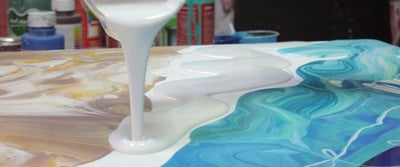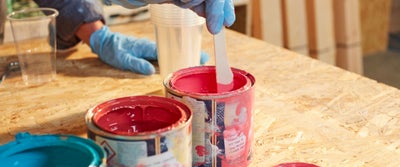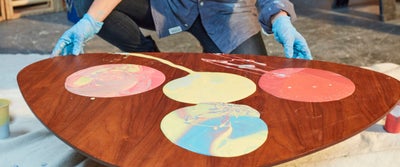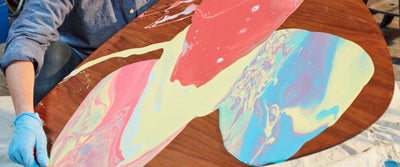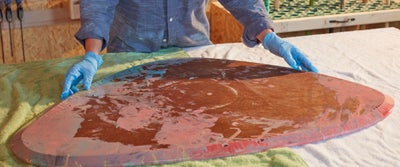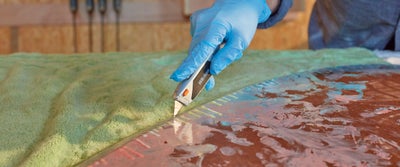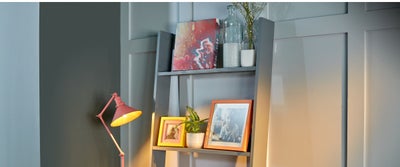How to create a paint poured coffee table
TOOLS
SAFETY
Planning & preparation
- We are going to show you how to paint pour a coffee table step by step.
- Paint pouring is a great way to revive and upcycle an otherwise unloved or tired piece of furniture, transforming your interior décor with a custom design. Not just for coffee tables, you can paint pour on most flat and clean surfaces, including tables, chairs, stools, canvases, coasters and ornaments.
- This project has lots of room for creativity. Our step by step instructions have been designed as a guide to give you a range of ideas, tips and techniques to create your own poured paint project.
- We recommend having a look online for paint pouring inspiration. This is a great way to gather colour scheme inspiration and ensure you have everything you need to hand before you begin this project.
- We used a selection of left-over coloured gloss paints for a fun and high-shine finish, but you can experiment with colour schemes and paint finishes for a different look.
- The materials for this project will cost around £30 depending on the size of your project and what you already have to hand. If you purchase materials for this project, you may find that you have left-over paint that can be used on other projects.
- This project will take a DIYer with moderate experience approximately 1 hour to complete, however, to ensure the paint has sufficient time to dry we recommend setting aside a minimum of 72 hours. For a solid cure, your project may need between two and four weeks to completely dry.
Doing it right
- The beauty of this project is in the experimentation as there is no one right way to pour paint. This guide includes a number of techniques, tips and advice for creating your own designs.
- The smoother the surface, the better the pour will be. Depending on the condition of your project, you may find that the surface needs some attention before you begin. If your project is already painted or has an uneven texture, give it a light sand back to smooth over the surface.
- If you need to fill any dents or deep scratches, give the wood filler time to dry before sanding back the surface for an invisible and smooth fill.
- If there are lots of superficial scratches or stains, priming can help to remedy and neutralise the surface. This will also help the paint adhere and ensure the surface is perfectly level for the best finish.
- Give the surface of your project a good clean and wipe down with a soft cloth to remove any dust, dirt or debris.
- Remove any fixtures and fittings that you don’t want to paint such as handles, doors, legs or a base before you begin. If they can’t be removed, use good quality decorating tape to protect them.
- If you decide to paint the legs, base or rest of your project in a complementary or contrasting colour, plan ahead so the paint has plenty of time to dry.
- Pouring paint is a messy job. We highly recommend that you protect the floor of your working area with dust sheets, plastic sheeting or bin liners to make cleaning up easier.
- When you’ve finished your project, discover our top tips for storing leftover paint.
- Your project will need some time to dry in a ventilated room after the pour. If you can, work in an open space away from foot traffic to minimise the risk of dust and dirt settling on the surface.
- Depending on how you use your project, it can be a good idea to seal your pour with a clear sealant. This is especially useful for projects that are likely to have high usage, making them more durable and water-resistant.
- Watch our top tip videos for our Wickes DIY skills, ideas and advice.
Staying safe
- Ensure your working area is well ventilated. Paint fumes can irritate skin and eyes, so it’s a good idea to wear protective goggles, a dust mask, old clothes and gloves during this project.
- Always check the manufacturer’s label before applying any paints, stains or treatments.



